System Analysis for Swinburne Guru Consulting
VerifiedAdded on 2023/01/19
|23
|4226
|63
AI Summary
This report provides an analysis of the coaching company called Swinburne Guru Consulting, including company background, challenges, and proposed solutions. It also covers functional and non-functional requirements, documentation, and references.
Contribute Materials
Your contribution can guide someone’s learning journey. Share your
documents today.

1System Analysis for Swinburne Guru Consulting
SYSTEM ANALYSIS FOR SWINBURNE GURU CONSULTING
By (student names)
[Course Name]
[Lecture Name]
[University Name]
[City where the university is located]
[Date]
SYSTEM ANALYSIS FOR SWINBURNE GURU CONSULTING
By (student names)
[Course Name]
[Lecture Name]
[University Name]
[City where the university is located]
[Date]
Secure Best Marks with AI Grader
Need help grading? Try our AI Grader for instant feedback on your assignments.
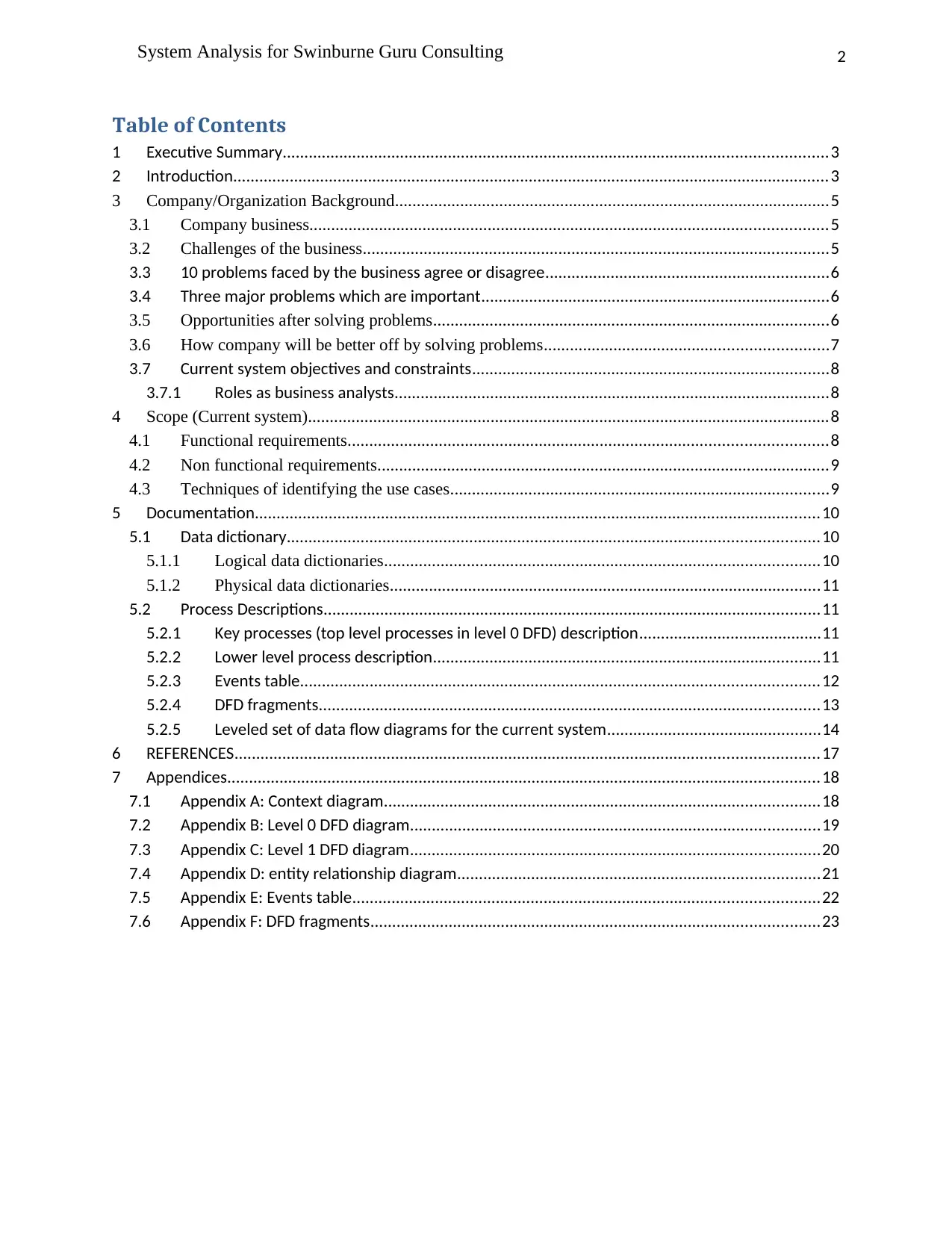
2System Analysis for Swinburne Guru Consulting
Table of Contents
1 Executive Summary.............................................................................................................................3
2 Introduction.........................................................................................................................................3
3 Company/Organization Background....................................................................................................5
3.1 Company business.......................................................................................................................5
3.2 Challenges of the business...........................................................................................................5
3.3 10 problems faced by the business agree or disagree.................................................................6
3.4 Three major problems which are important................................................................................6
3.5 Opportunities after solving problems...........................................................................................6
3.6 How company will be better off by solving problems.................................................................7
3.7 Current system objectives and constraints..................................................................................8
3.7.1 Roles as business analysts....................................................................................................8
4 Scope (Current system)........................................................................................................................8
4.1 Functional requirements..............................................................................................................8
4.2 Non functional requirements........................................................................................................9
4.3 Techniques of identifying the use cases.......................................................................................9
5 Documentation..................................................................................................................................10
5.1 Data dictionary..........................................................................................................................10
5.1.1 Logical data dictionaries....................................................................................................10
5.1.2 Physical data dictionaries...................................................................................................11
5.2 Process Descriptions..................................................................................................................11
5.2.1 Key processes (top level processes in level 0 DFD) description..........................................11
5.2.2 Lower level process description.........................................................................................11
5.2.3 Events table.......................................................................................................................12
5.2.4 DFD fragments...................................................................................................................13
5.2.5 Leveled set of data flow diagrams for the current system.................................................14
6 REFERENCES......................................................................................................................................17
7 Appendices........................................................................................................................................18
7.1 Appendix A: Context diagram....................................................................................................18
7.2 Appendix B: Level 0 DFD diagram..............................................................................................19
7.3 Appendix C: Level 1 DFD diagram..............................................................................................20
7.4 Appendix D: entity relationship diagram...................................................................................21
7.5 Appendix E: Events table...........................................................................................................22
7.6 Appendix F: DFD fragments.......................................................................................................23
Table of Contents
1 Executive Summary.............................................................................................................................3
2 Introduction.........................................................................................................................................3
3 Company/Organization Background....................................................................................................5
3.1 Company business.......................................................................................................................5
3.2 Challenges of the business...........................................................................................................5
3.3 10 problems faced by the business agree or disagree.................................................................6
3.4 Three major problems which are important................................................................................6
3.5 Opportunities after solving problems...........................................................................................6
3.6 How company will be better off by solving problems.................................................................7
3.7 Current system objectives and constraints..................................................................................8
3.7.1 Roles as business analysts....................................................................................................8
4 Scope (Current system)........................................................................................................................8
4.1 Functional requirements..............................................................................................................8
4.2 Non functional requirements........................................................................................................9
4.3 Techniques of identifying the use cases.......................................................................................9
5 Documentation..................................................................................................................................10
5.1 Data dictionary..........................................................................................................................10
5.1.1 Logical data dictionaries....................................................................................................10
5.1.2 Physical data dictionaries...................................................................................................11
5.2 Process Descriptions..................................................................................................................11
5.2.1 Key processes (top level processes in level 0 DFD) description..........................................11
5.2.2 Lower level process description.........................................................................................11
5.2.3 Events table.......................................................................................................................12
5.2.4 DFD fragments...................................................................................................................13
5.2.5 Leveled set of data flow diagrams for the current system.................................................14
6 REFERENCES......................................................................................................................................17
7 Appendices........................................................................................................................................18
7.1 Appendix A: Context diagram....................................................................................................18
7.2 Appendix B: Level 0 DFD diagram..............................................................................................19
7.3 Appendix C: Level 1 DFD diagram..............................................................................................20
7.4 Appendix D: entity relationship diagram...................................................................................21
7.5 Appendix E: Events table...........................................................................................................22
7.6 Appendix F: DFD fragments.......................................................................................................23
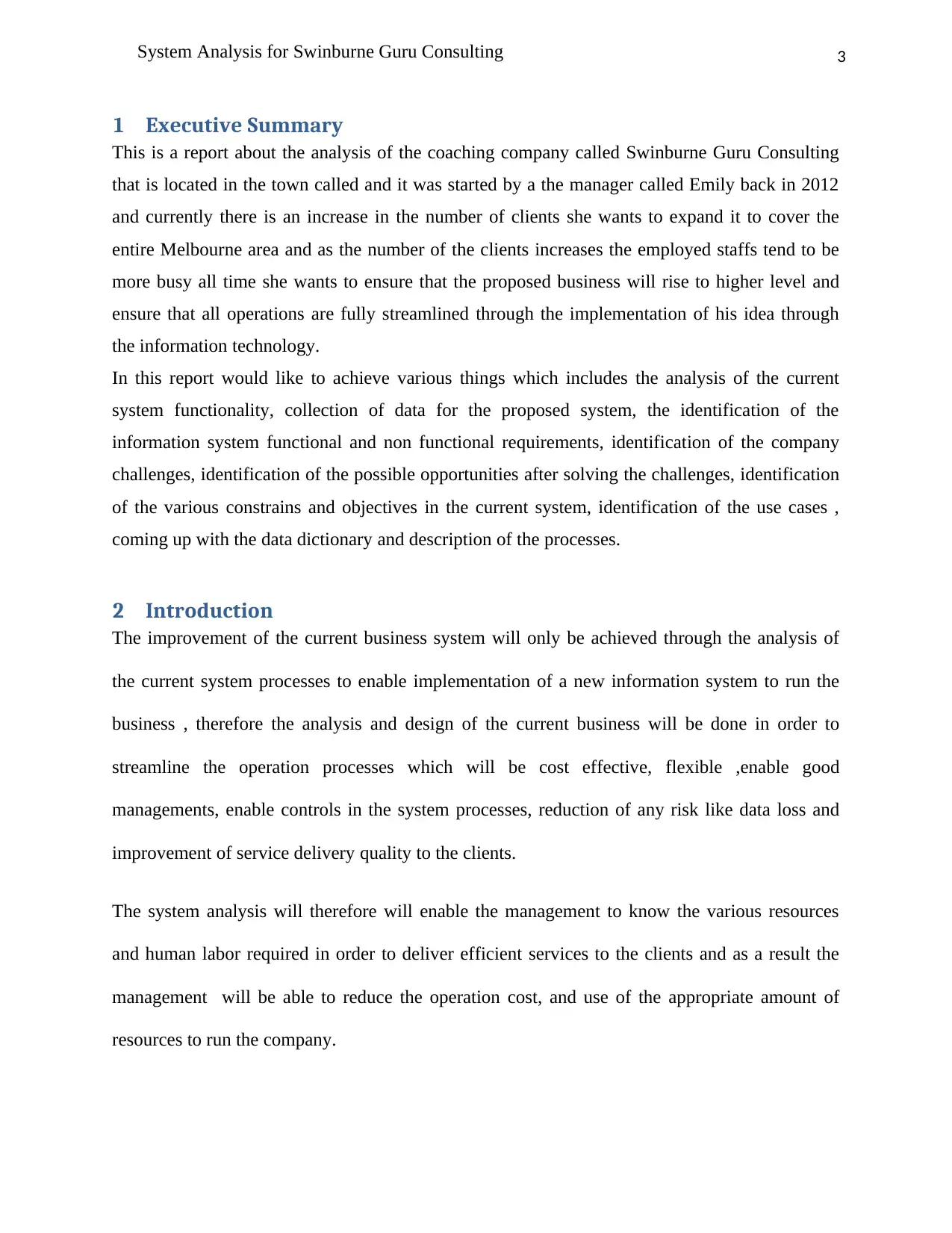
3System Analysis for Swinburne Guru Consulting
1 Executive Summary
This is a report about the analysis of the coaching company called Swinburne Guru Consulting
that is located in the town called and it was started by a the manager called Emily back in 2012
and currently there is an increase in the number of clients she wants to expand it to cover the
entire Melbourne area and as the number of the clients increases the employed staffs tend to be
more busy all time she wants to ensure that the proposed business will rise to higher level and
ensure that all operations are fully streamlined through the implementation of his idea through
the information technology.
In this report would like to achieve various things which includes the analysis of the current
system functionality, collection of data for the proposed system, the identification of the
information system functional and non functional requirements, identification of the company
challenges, identification of the possible opportunities after solving the challenges, identification
of the various constrains and objectives in the current system, identification of the use cases ,
coming up with the data dictionary and description of the processes.
2 Introduction
The improvement of the current business system will only be achieved through the analysis of
the current system processes to enable implementation of a new information system to run the
business , therefore the analysis and design of the current business will be done in order to
streamline the operation processes which will be cost effective, flexible ,enable good
managements, enable controls in the system processes, reduction of any risk like data loss and
improvement of service delivery quality to the clients.
The system analysis will therefore will enable the management to know the various resources
and human labor required in order to deliver efficient services to the clients and as a result the
management will be able to reduce the operation cost, and use of the appropriate amount of
resources to run the company.
1 Executive Summary
This is a report about the analysis of the coaching company called Swinburne Guru Consulting
that is located in the town called and it was started by a the manager called Emily back in 2012
and currently there is an increase in the number of clients she wants to expand it to cover the
entire Melbourne area and as the number of the clients increases the employed staffs tend to be
more busy all time she wants to ensure that the proposed business will rise to higher level and
ensure that all operations are fully streamlined through the implementation of his idea through
the information technology.
In this report would like to achieve various things which includes the analysis of the current
system functionality, collection of data for the proposed system, the identification of the
information system functional and non functional requirements, identification of the company
challenges, identification of the possible opportunities after solving the challenges, identification
of the various constrains and objectives in the current system, identification of the use cases ,
coming up with the data dictionary and description of the processes.
2 Introduction
The improvement of the current business system will only be achieved through the analysis of
the current system processes to enable implementation of a new information system to run the
business , therefore the analysis and design of the current business will be done in order to
streamline the operation processes which will be cost effective, flexible ,enable good
managements, enable controls in the system processes, reduction of any risk like data loss and
improvement of service delivery quality to the clients.
The system analysis will therefore will enable the management to know the various resources
and human labor required in order to deliver efficient services to the clients and as a result the
management will be able to reduce the operation cost, and use of the appropriate amount of
resources to run the company.
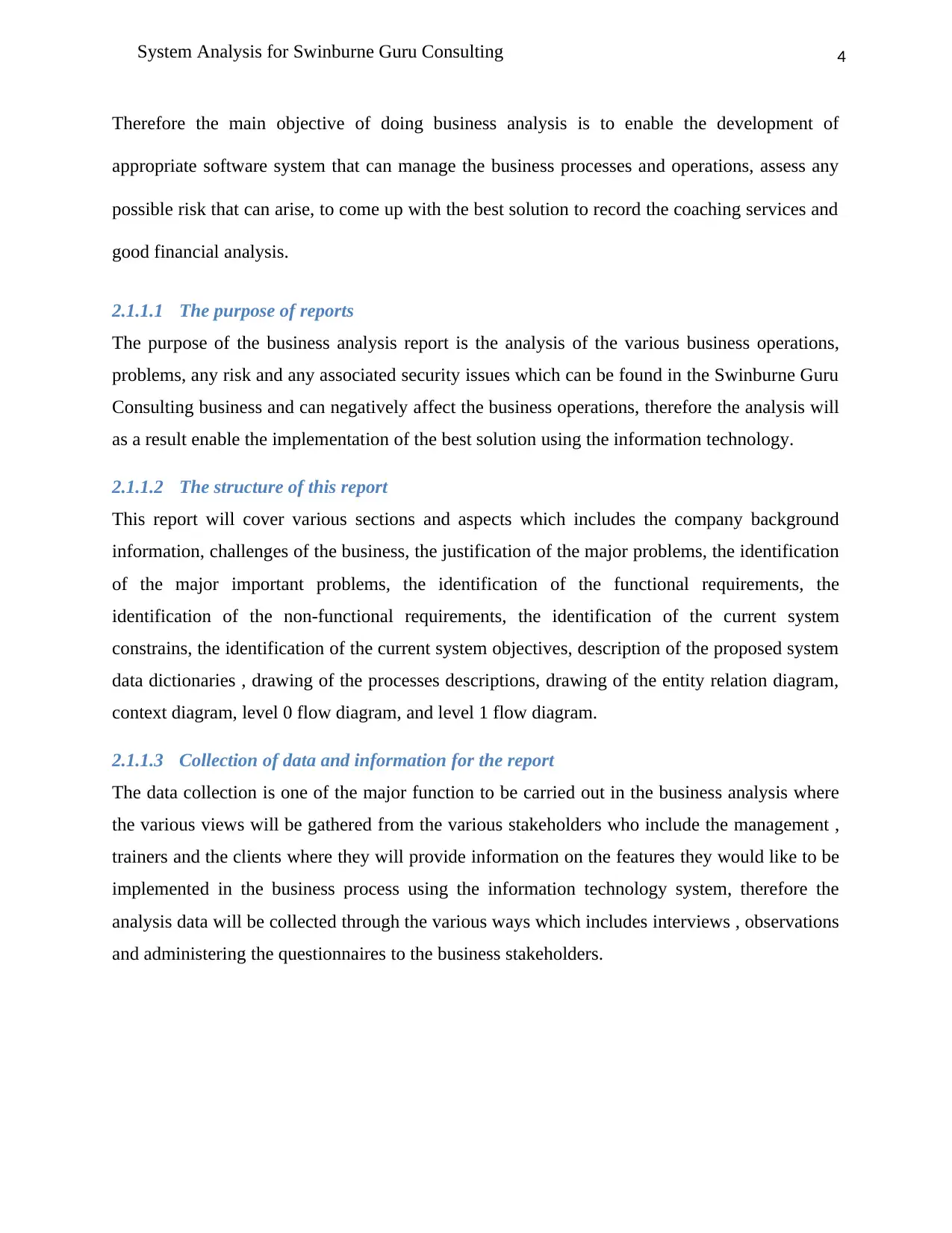
4System Analysis for Swinburne Guru Consulting
Therefore the main objective of doing business analysis is to enable the development of
appropriate software system that can manage the business processes and operations, assess any
possible risk that can arise, to come up with the best solution to record the coaching services and
good financial analysis.
2.1.1.1 The purpose of reports
The purpose of the business analysis report is the analysis of the various business operations,
problems, any risk and any associated security issues which can be found in the Swinburne Guru
Consulting business and can negatively affect the business operations, therefore the analysis will
as a result enable the implementation of the best solution using the information technology.
2.1.1.2 The structure of this report
This report will cover various sections and aspects which includes the company background
information, challenges of the business, the justification of the major problems, the identification
of the major important problems, the identification of the functional requirements, the
identification of the non-functional requirements, the identification of the current system
constrains, the identification of the current system objectives, description of the proposed system
data dictionaries , drawing of the processes descriptions, drawing of the entity relation diagram,
context diagram, level 0 flow diagram, and level 1 flow diagram.
2.1.1.3 Collection of data and information for the report
The data collection is one of the major function to be carried out in the business analysis where
the various views will be gathered from the various stakeholders who include the management ,
trainers and the clients where they will provide information on the features they would like to be
implemented in the business process using the information technology system, therefore the
analysis data will be collected through the various ways which includes interviews , observations
and administering the questionnaires to the business stakeholders.
Therefore the main objective of doing business analysis is to enable the development of
appropriate software system that can manage the business processes and operations, assess any
possible risk that can arise, to come up with the best solution to record the coaching services and
good financial analysis.
2.1.1.1 The purpose of reports
The purpose of the business analysis report is the analysis of the various business operations,
problems, any risk and any associated security issues which can be found in the Swinburne Guru
Consulting business and can negatively affect the business operations, therefore the analysis will
as a result enable the implementation of the best solution using the information technology.
2.1.1.2 The structure of this report
This report will cover various sections and aspects which includes the company background
information, challenges of the business, the justification of the major problems, the identification
of the major important problems, the identification of the functional requirements, the
identification of the non-functional requirements, the identification of the current system
constrains, the identification of the current system objectives, description of the proposed system
data dictionaries , drawing of the processes descriptions, drawing of the entity relation diagram,
context diagram, level 0 flow diagram, and level 1 flow diagram.
2.1.1.3 Collection of data and information for the report
The data collection is one of the major function to be carried out in the business analysis where
the various views will be gathered from the various stakeholders who include the management ,
trainers and the clients where they will provide information on the features they would like to be
implemented in the business process using the information technology system, therefore the
analysis data will be collected through the various ways which includes interviews , observations
and administering the questionnaires to the business stakeholders.
Secure Best Marks with AI Grader
Need help grading? Try our AI Grader for instant feedback on your assignments.
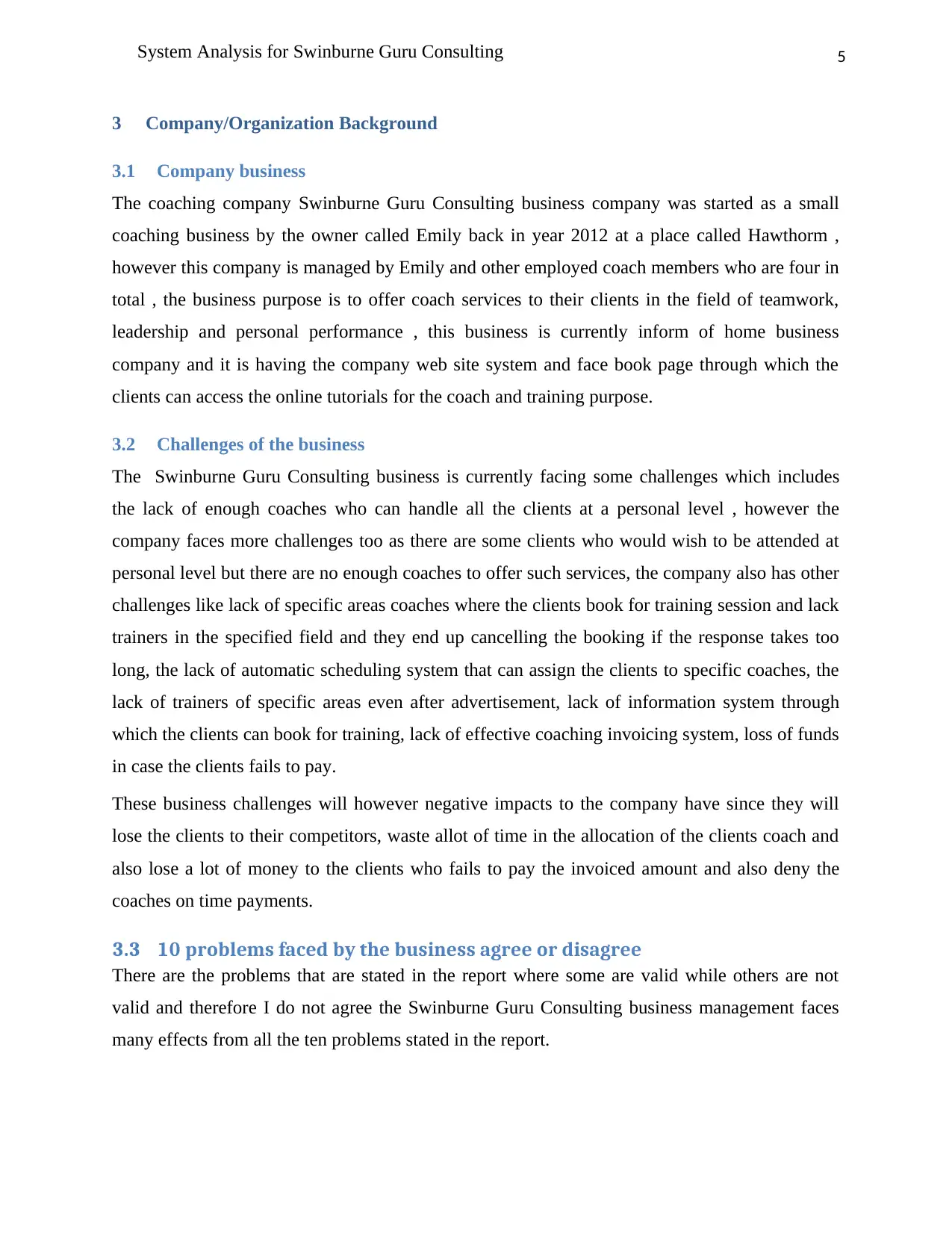
5System Analysis for Swinburne Guru Consulting
3 Company/Organization Background
3.1 Company business
The coaching company Swinburne Guru Consulting business company was started as a small
coaching business by the owner called Emily back in year 2012 at a place called Hawthorm ,
however this company is managed by Emily and other employed coach members who are four in
total , the business purpose is to offer coach services to their clients in the field of teamwork,
leadership and personal performance , this business is currently inform of home business
company and it is having the company web site system and face book page through which the
clients can access the online tutorials for the coach and training purpose.
3.2 Challenges of the business
The Swinburne Guru Consulting business is currently facing some challenges which includes
the lack of enough coaches who can handle all the clients at a personal level , however the
company faces more challenges too as there are some clients who would wish to be attended at
personal level but there are no enough coaches to offer such services, the company also has other
challenges like lack of specific areas coaches where the clients book for training session and lack
trainers in the specified field and they end up cancelling the booking if the response takes too
long, the lack of automatic scheduling system that can assign the clients to specific coaches, the
lack of trainers of specific areas even after advertisement, lack of information system through
which the clients can book for training, lack of effective coaching invoicing system, loss of funds
in case the clients fails to pay.
These business challenges will however negative impacts to the company have since they will
lose the clients to their competitors, waste allot of time in the allocation of the clients coach and
also lose a lot of money to the clients who fails to pay the invoiced amount and also deny the
coaches on time payments.
3.3 10 problems faced by the business agree or disagree
There are the problems that are stated in the report where some are valid while others are not
valid and therefore I do not agree the Swinburne Guru Consulting business management faces
many effects from all the ten problems stated in the report.
3 Company/Organization Background
3.1 Company business
The coaching company Swinburne Guru Consulting business company was started as a small
coaching business by the owner called Emily back in year 2012 at a place called Hawthorm ,
however this company is managed by Emily and other employed coach members who are four in
total , the business purpose is to offer coach services to their clients in the field of teamwork,
leadership and personal performance , this business is currently inform of home business
company and it is having the company web site system and face book page through which the
clients can access the online tutorials for the coach and training purpose.
3.2 Challenges of the business
The Swinburne Guru Consulting business is currently facing some challenges which includes
the lack of enough coaches who can handle all the clients at a personal level , however the
company faces more challenges too as there are some clients who would wish to be attended at
personal level but there are no enough coaches to offer such services, the company also has other
challenges like lack of specific areas coaches where the clients book for training session and lack
trainers in the specified field and they end up cancelling the booking if the response takes too
long, the lack of automatic scheduling system that can assign the clients to specific coaches, the
lack of trainers of specific areas even after advertisement, lack of information system through
which the clients can book for training, lack of effective coaching invoicing system, loss of funds
in case the clients fails to pay.
These business challenges will however negative impacts to the company have since they will
lose the clients to their competitors, waste allot of time in the allocation of the clients coach and
also lose a lot of money to the clients who fails to pay the invoiced amount and also deny the
coaches on time payments.
3.3 10 problems faced by the business agree or disagree
There are the problems that are stated in the report where some are valid while others are not
valid and therefore I do not agree the Swinburne Guru Consulting business management faces
many effects from all the ten problems stated in the report.
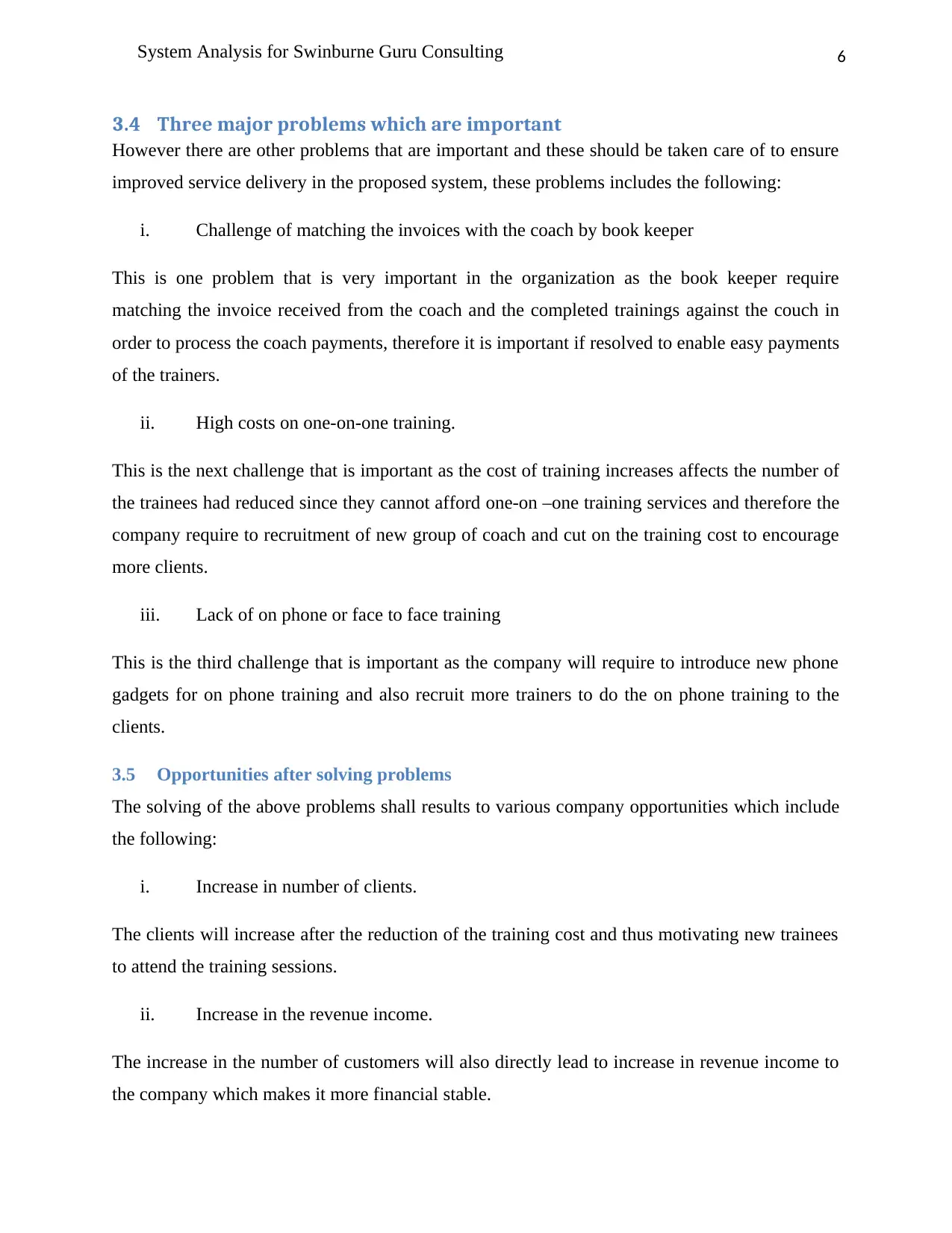
6System Analysis for Swinburne Guru Consulting
3.4 Three major problems which are important
However there are other problems that are important and these should be taken care of to ensure
improved service delivery in the proposed system, these problems includes the following:
i. Challenge of matching the invoices with the coach by book keeper
This is one problem that is very important in the organization as the book keeper require
matching the invoice received from the coach and the completed trainings against the couch in
order to process the coach payments, therefore it is important if resolved to enable easy payments
of the trainers.
ii. High costs on one-on-one training.
This is the next challenge that is important as the cost of training increases affects the number of
the trainees had reduced since they cannot afford one-on –one training services and therefore the
company require to recruitment of new group of coach and cut on the training cost to encourage
more clients.
iii. Lack of on phone or face to face training
This is the third challenge that is important as the company will require to introduce new phone
gadgets for on phone training and also recruit more trainers to do the on phone training to the
clients.
3.5 Opportunities after solving problems
The solving of the above problems shall results to various company opportunities which include
the following:
i. Increase in number of clients.
The clients will increase after the reduction of the training cost and thus motivating new trainees
to attend the training sessions.
ii. Increase in the revenue income.
The increase in the number of customers will also directly lead to increase in revenue income to
the company which makes it more financial stable.
3.4 Three major problems which are important
However there are other problems that are important and these should be taken care of to ensure
improved service delivery in the proposed system, these problems includes the following:
i. Challenge of matching the invoices with the coach by book keeper
This is one problem that is very important in the organization as the book keeper require
matching the invoice received from the coach and the completed trainings against the couch in
order to process the coach payments, therefore it is important if resolved to enable easy payments
of the trainers.
ii. High costs on one-on-one training.
This is the next challenge that is important as the cost of training increases affects the number of
the trainees had reduced since they cannot afford one-on –one training services and therefore the
company require to recruitment of new group of coach and cut on the training cost to encourage
more clients.
iii. Lack of on phone or face to face training
This is the third challenge that is important as the company will require to introduce new phone
gadgets for on phone training and also recruit more trainers to do the on phone training to the
clients.
3.5 Opportunities after solving problems
The solving of the above problems shall results to various company opportunities which include
the following:
i. Increase in number of clients.
The clients will increase after the reduction of the training cost and thus motivating new trainees
to attend the training sessions.
ii. Increase in the revenue income.
The increase in the number of customers will also directly lead to increase in revenue income to
the company which makes it more financial stable.
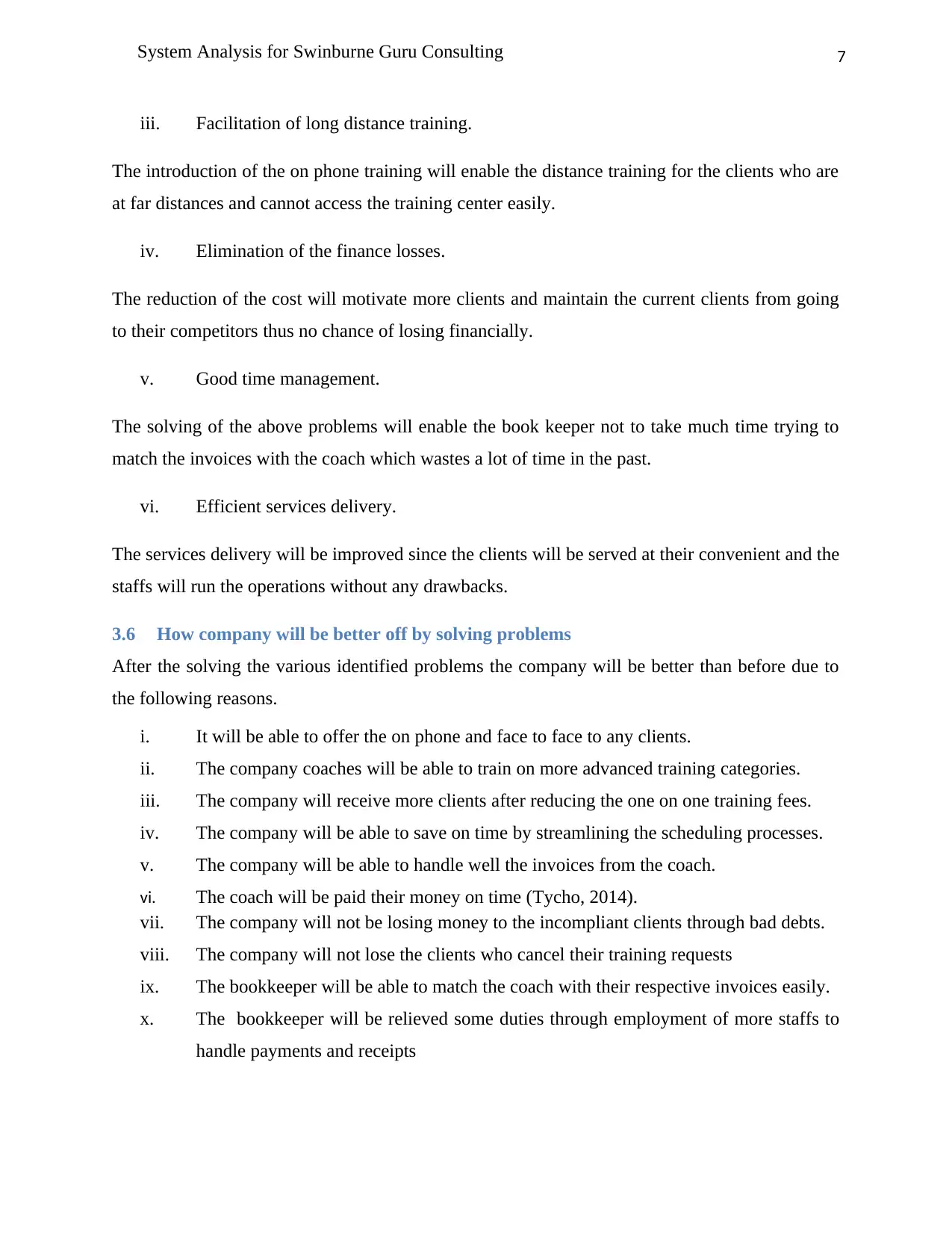
7System Analysis for Swinburne Guru Consulting
iii. Facilitation of long distance training.
The introduction of the on phone training will enable the distance training for the clients who are
at far distances and cannot access the training center easily.
iv. Elimination of the finance losses.
The reduction of the cost will motivate more clients and maintain the current clients from going
to their competitors thus no chance of losing financially.
v. Good time management.
The solving of the above problems will enable the book keeper not to take much time trying to
match the invoices with the coach which wastes a lot of time in the past.
vi. Efficient services delivery.
The services delivery will be improved since the clients will be served at their convenient and the
staffs will run the operations without any drawbacks.
3.6 How company will be better off by solving problems
After the solving the various identified problems the company will be better than before due to
the following reasons.
i. It will be able to offer the on phone and face to face to any clients.
ii. The company coaches will be able to train on more advanced training categories.
iii. The company will receive more clients after reducing the one on one training fees.
iv. The company will be able to save on time by streamlining the scheduling processes.
v. The company will be able to handle well the invoices from the coach.
vi. The coach will be paid their money on time (Tycho, 2014).
vii. The company will not be losing money to the incompliant clients through bad debts.
viii. The company will not lose the clients who cancel their training requests
ix. The bookkeeper will be able to match the coach with their respective invoices easily.
x. The bookkeeper will be relieved some duties through employment of more staffs to
handle payments and receipts
iii. Facilitation of long distance training.
The introduction of the on phone training will enable the distance training for the clients who are
at far distances and cannot access the training center easily.
iv. Elimination of the finance losses.
The reduction of the cost will motivate more clients and maintain the current clients from going
to their competitors thus no chance of losing financially.
v. Good time management.
The solving of the above problems will enable the book keeper not to take much time trying to
match the invoices with the coach which wastes a lot of time in the past.
vi. Efficient services delivery.
The services delivery will be improved since the clients will be served at their convenient and the
staffs will run the operations without any drawbacks.
3.6 How company will be better off by solving problems
After the solving the various identified problems the company will be better than before due to
the following reasons.
i. It will be able to offer the on phone and face to face to any clients.
ii. The company coaches will be able to train on more advanced training categories.
iii. The company will receive more clients after reducing the one on one training fees.
iv. The company will be able to save on time by streamlining the scheduling processes.
v. The company will be able to handle well the invoices from the coach.
vi. The coach will be paid their money on time (Tycho, 2014).
vii. The company will not be losing money to the incompliant clients through bad debts.
viii. The company will not lose the clients who cancel their training requests
ix. The bookkeeper will be able to match the coach with their respective invoices easily.
x. The bookkeeper will be relieved some duties through employment of more staffs to
handle payments and receipts
Paraphrase This Document
Need a fresh take? Get an instant paraphrase of this document with our AI Paraphraser
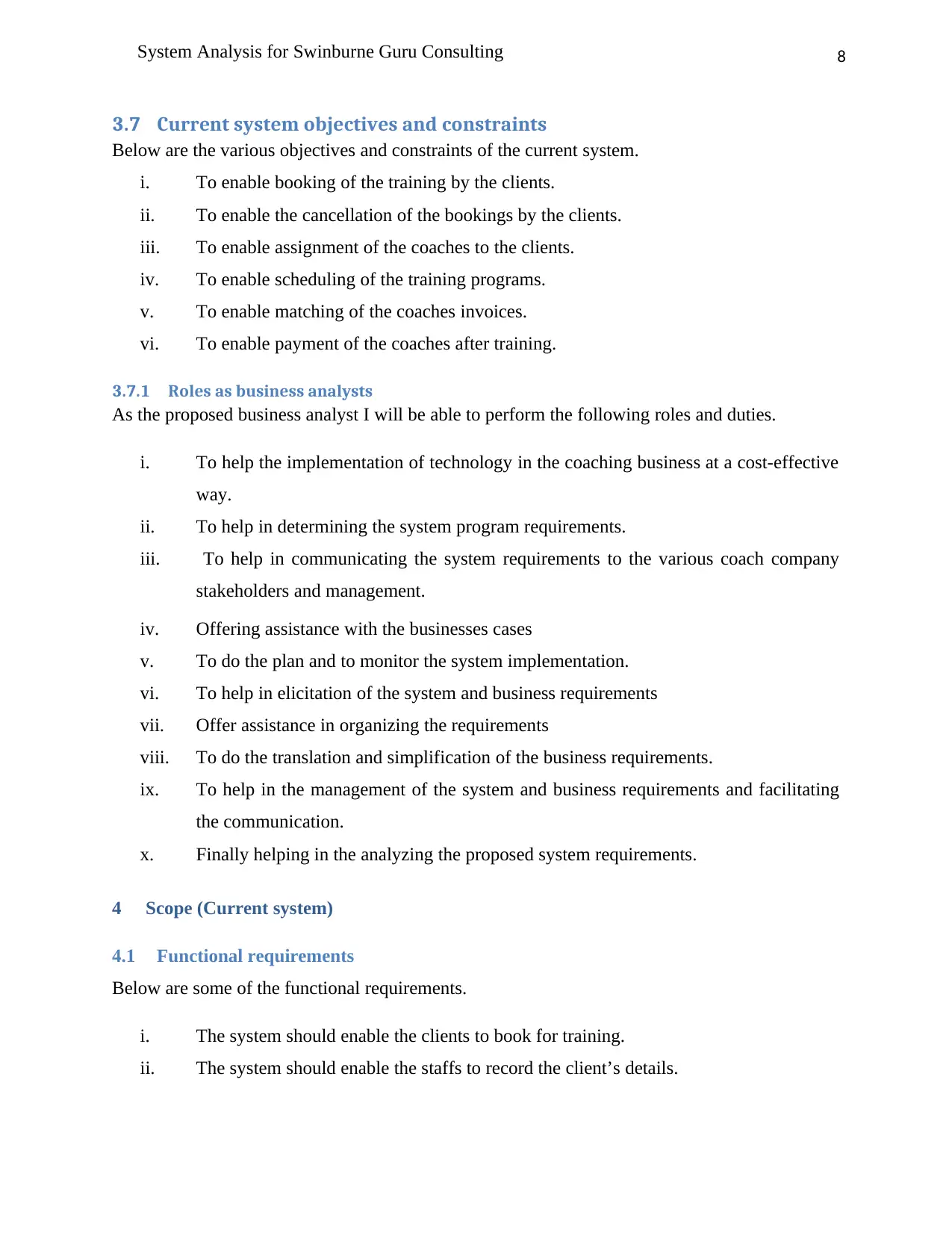
8System Analysis for Swinburne Guru Consulting
3.7 Current system objectives and constraints
Below are the various objectives and constraints of the current system.
i. To enable booking of the training by the clients.
ii. To enable the cancellation of the bookings by the clients.
iii. To enable assignment of the coaches to the clients.
iv. To enable scheduling of the training programs.
v. To enable matching of the coaches invoices.
vi. To enable payment of the coaches after training.
3.7.1 Roles as business analysts
As the proposed business analyst I will be able to perform the following roles and duties.
i. To help the implementation of technology in the coaching business at a cost-effective
way.
ii. To help in determining the system program requirements.
iii. To help in communicating the system requirements to the various coach company
stakeholders and management.
iv. Offering assistance with the businesses cases
v. To do the plan and to monitor the system implementation.
vi. To help in elicitation of the system and business requirements
vii. Offer assistance in organizing the requirements
viii. To do the translation and simplification of the business requirements.
ix. To help in the management of the system and business requirements and facilitating
the communication.
x. Finally helping in the analyzing the proposed system requirements.
4 Scope (Current system)
4.1 Functional requirements
Below are some of the functional requirements.
i. The system should enable the clients to book for training.
ii. The system should enable the staffs to record the client’s details.
3.7 Current system objectives and constraints
Below are the various objectives and constraints of the current system.
i. To enable booking of the training by the clients.
ii. To enable the cancellation of the bookings by the clients.
iii. To enable assignment of the coaches to the clients.
iv. To enable scheduling of the training programs.
v. To enable matching of the coaches invoices.
vi. To enable payment of the coaches after training.
3.7.1 Roles as business analysts
As the proposed business analyst I will be able to perform the following roles and duties.
i. To help the implementation of technology in the coaching business at a cost-effective
way.
ii. To help in determining the system program requirements.
iii. To help in communicating the system requirements to the various coach company
stakeholders and management.
iv. Offering assistance with the businesses cases
v. To do the plan and to monitor the system implementation.
vi. To help in elicitation of the system and business requirements
vii. Offer assistance in organizing the requirements
viii. To do the translation and simplification of the business requirements.
ix. To help in the management of the system and business requirements and facilitating
the communication.
x. Finally helping in the analyzing the proposed system requirements.
4 Scope (Current system)
4.1 Functional requirements
Below are some of the functional requirements.
i. The system should enable the clients to book for training.
ii. The system should enable the staffs to record the client’s details.

9System Analysis for Swinburne Guru Consulting
iii. The system should enable the staffs to assign the coaches to various clients of training
groups.
iv. The system should enable the scheduling of the training programs.
v. The system should enable the bookkeeper to match the coach invoices.
vi. The system should enable the payment for the training to the coaches.
4.2 Non functional requirements
Below are some of the non-functional requirements for the current system.
i. Availability: The proposed system should be able to be available to the users at any
given period of time when the users want to use it.
ii. Reliability: The proposed system should be reliable such that no any time should the
user need the system and fail to access it.
iii. Security: The system should be secure such that it provides security to the users of the
system, including their login details and passwords.
iv. Efficiency: The system should be able to be used easily and all operations should be
efficient at any given time.
v. Consistency: The system should be consistent in its operations such that any output
results will remain constant without any alterations in the next system execution.
4.3 Techniques of identifying the use cases
i. The User goal technique: This is the process of identifying the purpose and the aims of
the various users of the system and thus making it easy to extract the use cases, the use of
this technique helped to identify the system goals and objectives to be achieved by the
user of the system, then the events are then decomposed into smaller events to identify
the use cases through the identification of the external business events that need the
system response.
ii. The CRUD technique: The CRUD diagram is used to relate the function of the various
system entities and thus a good tool to extract the use cases, this technique identifies the
use cases where it uses the create, read, report, update and delete and through these
operations the system analyst identify data elements which requires processing proposed
system and therefore it creates the system use cases which creates, reports on, updates,
and deletes the data items (Dick, 2018).
iii. The system should enable the staffs to assign the coaches to various clients of training
groups.
iv. The system should enable the scheduling of the training programs.
v. The system should enable the bookkeeper to match the coach invoices.
vi. The system should enable the payment for the training to the coaches.
4.2 Non functional requirements
Below are some of the non-functional requirements for the current system.
i. Availability: The proposed system should be able to be available to the users at any
given period of time when the users want to use it.
ii. Reliability: The proposed system should be reliable such that no any time should the
user need the system and fail to access it.
iii. Security: The system should be secure such that it provides security to the users of the
system, including their login details and passwords.
iv. Efficiency: The system should be able to be used easily and all operations should be
efficient at any given time.
v. Consistency: The system should be consistent in its operations such that any output
results will remain constant without any alterations in the next system execution.
4.3 Techniques of identifying the use cases
i. The User goal technique: This is the process of identifying the purpose and the aims of
the various users of the system and thus making it easy to extract the use cases, the use of
this technique helped to identify the system goals and objectives to be achieved by the
user of the system, then the events are then decomposed into smaller events to identify
the use cases through the identification of the external business events that need the
system response.
ii. The CRUD technique: The CRUD diagram is used to relate the function of the various
system entities and thus a good tool to extract the use cases, this technique identifies the
use cases where it uses the create, read, report, update and delete and through these
operations the system analyst identify data elements which requires processing proposed
system and therefore it creates the system use cases which creates, reports on, updates,
and deletes the data items (Dick, 2018).
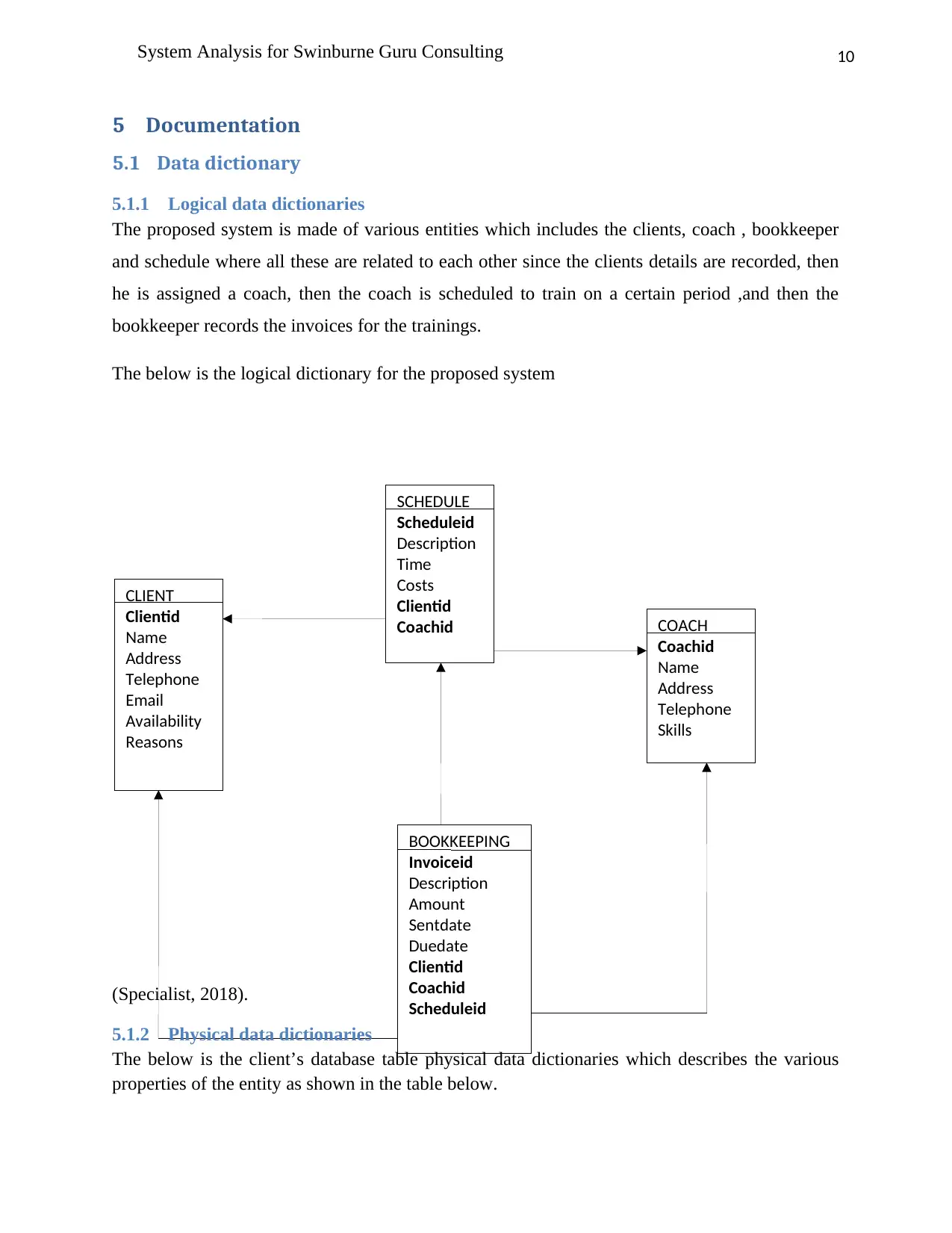
10System Analysis for Swinburne Guru Consulting
CLIENT
Clientid
Name
Address
Telephone
Email
Availability
Reasons
COACH
Coachid
Name
Address
Telephone
Skills
SCHEDULE
Scheduleid
Description
Time
Costs
Clientid
Coachid
BOOKKEEPING
Invoiceid
Description
Amount
Sentdate
Duedate
Clientid
Coachid
Scheduleid
5 Documentation
5.1 Data dictionary
5.1.1 Logical data dictionaries
The proposed system is made of various entities which includes the clients, coach , bookkeeper
and schedule where all these are related to each other since the clients details are recorded, then
he is assigned a coach, then the coach is scheduled to train on a certain period ,and then the
bookkeeper records the invoices for the trainings.
The below is the logical dictionary for the proposed system
(Specialist, 2018).
5.1.2 Physical data dictionaries
The below is the client’s database table physical data dictionaries which describes the various
properties of the entity as shown in the table below.
CLIENT
Clientid
Name
Address
Telephone
Availability
Reasons
COACH
Coachid
Name
Address
Telephone
Skills
SCHEDULE
Scheduleid
Description
Time
Costs
Clientid
Coachid
BOOKKEEPING
Invoiceid
Description
Amount
Sentdate
Duedate
Clientid
Coachid
Scheduleid
5 Documentation
5.1 Data dictionary
5.1.1 Logical data dictionaries
The proposed system is made of various entities which includes the clients, coach , bookkeeper
and schedule where all these are related to each other since the clients details are recorded, then
he is assigned a coach, then the coach is scheduled to train on a certain period ,and then the
bookkeeper records the invoices for the trainings.
The below is the logical dictionary for the proposed system
(Specialist, 2018).
5.1.2 Physical data dictionaries
The below is the client’s database table physical data dictionaries which describes the various
properties of the entity as shown in the table below.
Secure Best Marks with AI Grader
Need help grading? Try our AI Grader for instant feedback on your assignments.
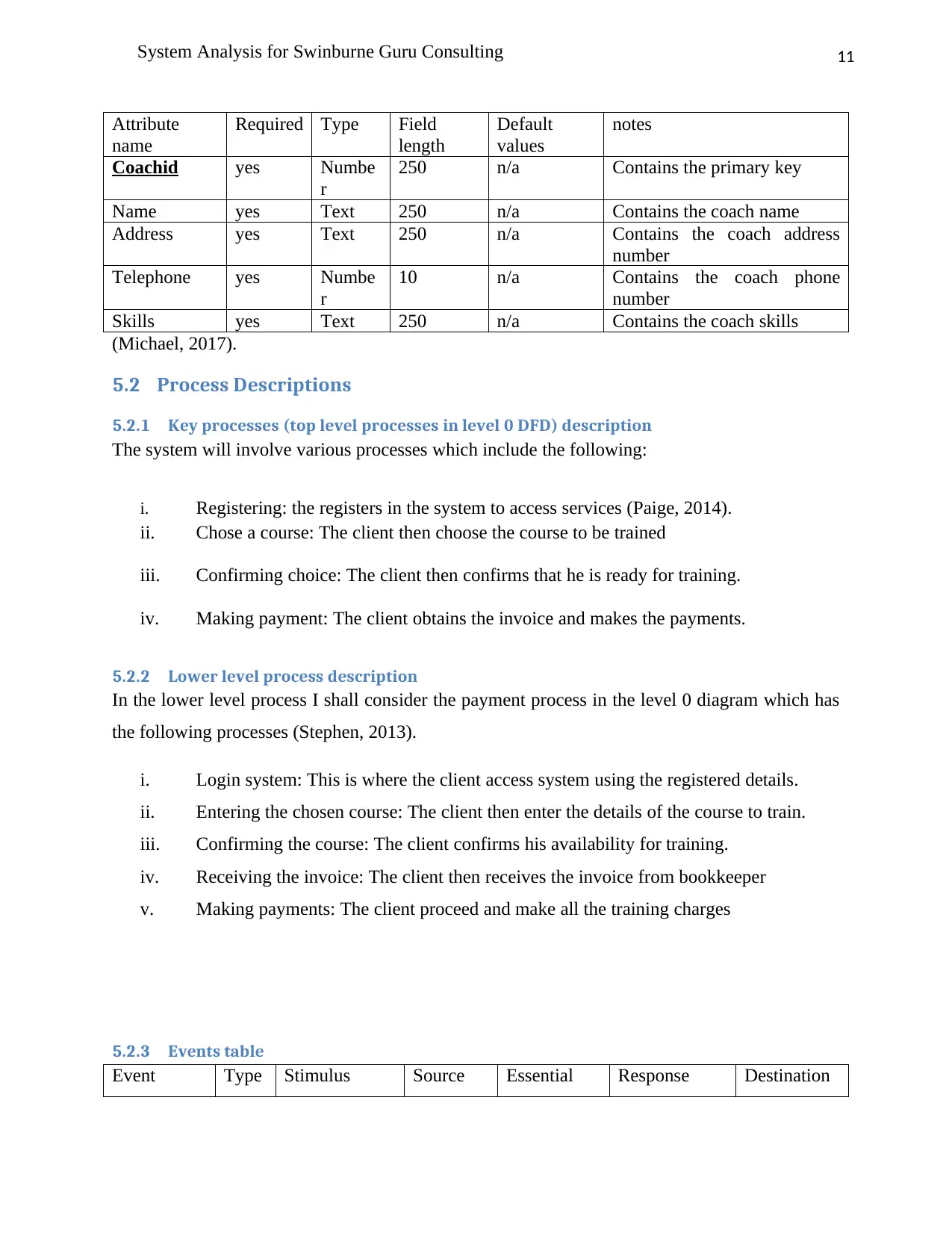
11System Analysis for Swinburne Guru Consulting
Attribute
name
Required Type Field
length
Default
values
notes
Coachid yes Numbe
r
250 n/a Contains the primary key
Name yes Text 250 n/a Contains the coach name
Address yes Text 250 n/a Contains the coach address
number
Telephone yes Numbe
r
10 n/a Contains the coach phone
number
Skills yes Text 250 n/a Contains the coach skills
(Michael, 2017).
5.2 Process Descriptions
5.2.1 Key processes (top level processes in level 0 DFD) description
The system will involve various processes which include the following:
i. Registering: the registers in the system to access services (Paige, 2014).
ii. Chose a course: The client then choose the course to be trained
iii. Confirming choice: The client then confirms that he is ready for training.
iv. Making payment: The client obtains the invoice and makes the payments.
5.2.2 Lower level process description
In the lower level process I shall consider the payment process in the level 0 diagram which has
the following processes (Stephen, 2013).
i. Login system: This is where the client access system using the registered details.
ii. Entering the chosen course: The client then enter the details of the course to train.
iii. Confirming the course: The client confirms his availability for training.
iv. Receiving the invoice: The client then receives the invoice from bookkeeper
v. Making payments: The client proceed and make all the training charges
5.2.3 Events table
Event Type Stimulus Source Essential Response Destination
Attribute
name
Required Type Field
length
Default
values
notes
Coachid yes Numbe
r
250 n/a Contains the primary key
Name yes Text 250 n/a Contains the coach name
Address yes Text 250 n/a Contains the coach address
number
Telephone yes Numbe
r
10 n/a Contains the coach phone
number
Skills yes Text 250 n/a Contains the coach skills
(Michael, 2017).
5.2 Process Descriptions
5.2.1 Key processes (top level processes in level 0 DFD) description
The system will involve various processes which include the following:
i. Registering: the registers in the system to access services (Paige, 2014).
ii. Chose a course: The client then choose the course to be trained
iii. Confirming choice: The client then confirms that he is ready for training.
iv. Making payment: The client obtains the invoice and makes the payments.
5.2.2 Lower level process description
In the lower level process I shall consider the payment process in the level 0 diagram which has
the following processes (Stephen, 2013).
i. Login system: This is where the client access system using the registered details.
ii. Entering the chosen course: The client then enter the details of the course to train.
iii. Confirming the course: The client confirms his availability for training.
iv. Receiving the invoice: The client then receives the invoice from bookkeeper
v. Making payments: The client proceed and make all the training charges
5.2.3 Events table
Event Type Stimulus Source Essential Response Destination
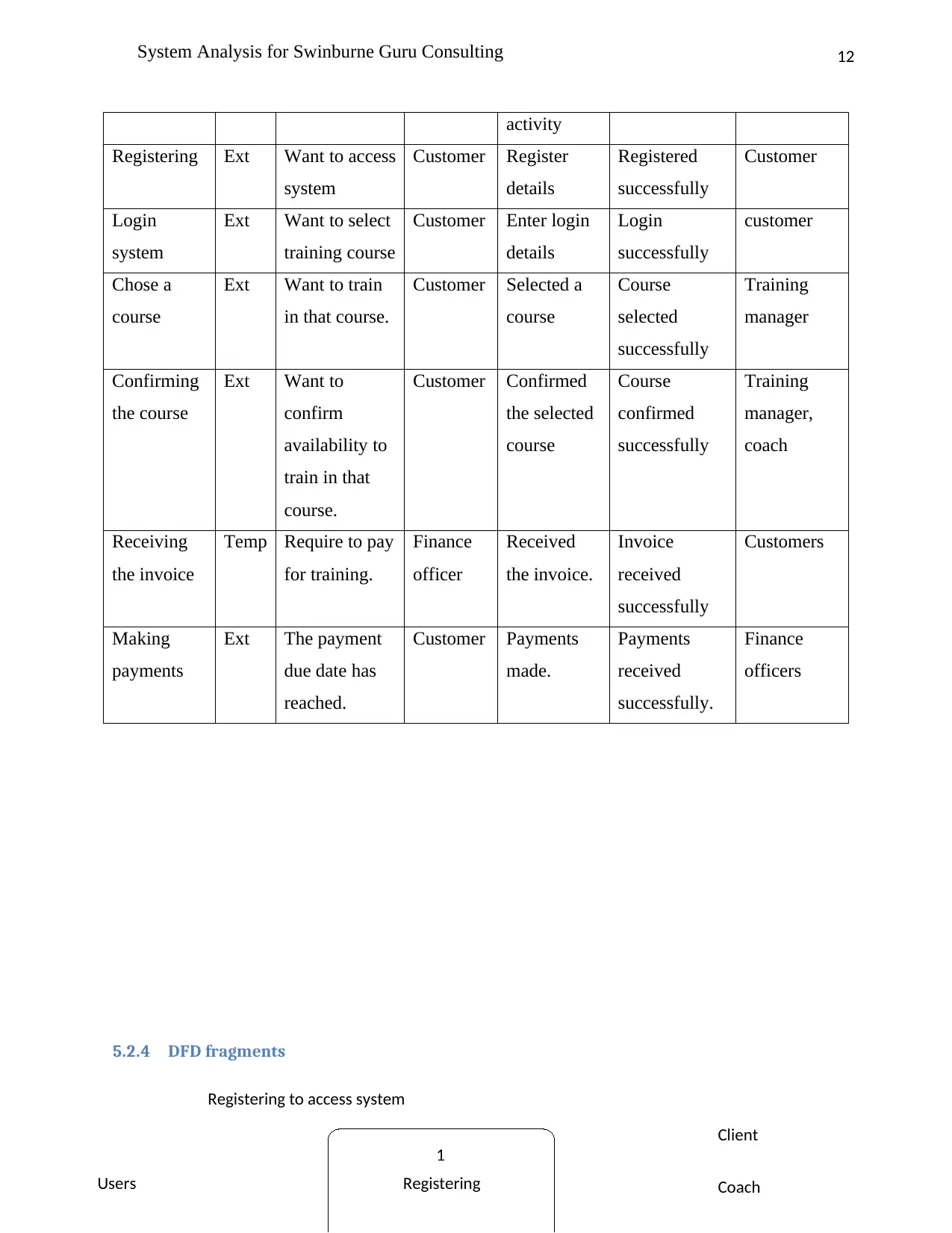
12System Analysis for Swinburne Guru Consulting
1
RegisteringUsers
Registering to access system
Client
Coach
activity
Registering Ext Want to access
system
Customer Register
details
Registered
successfully
Customer
Login
system
Ext Want to select
training course
Customer Enter login
details
Login
successfully
customer
Chose a
course
Ext Want to train
in that course.
Customer Selected a
course
Course
selected
successfully
Training
manager
Confirming
the course
Ext Want to
confirm
availability to
train in that
course.
Customer Confirmed
the selected
course
Course
confirmed
successfully
Training
manager,
coach
Receiving
the invoice
Temp Require to pay
for training.
Finance
officer
Received
the invoice.
Invoice
received
successfully
Customers
Making
payments
Ext The payment
due date has
reached.
Customer Payments
made.
Payments
received
successfully.
Finance
officers
5.2.4 DFD fragments
1
RegisteringUsers
Registering to access system
Client
Coach
activity
Registering Ext Want to access
system
Customer Register
details
Registered
successfully
Customer
Login
system
Ext Want to select
training course
Customer Enter login
details
Login
successfully
customer
Chose a
course
Ext Want to train
in that course.
Customer Selected a
course
Course
selected
successfully
Training
manager
Confirming
the course
Ext Want to
confirm
availability to
train in that
course.
Customer Confirmed
the selected
course
Course
confirmed
successfully
Training
manager,
coach
Receiving
the invoice
Temp Require to pay
for training.
Finance
officer
Received
the invoice.
Invoice
received
successfully
Customers
Making
payments
Ext The payment
due date has
reached.
Customer Payments
made.
Payments
received
successfully.
Finance
officers
5.2.4 DFD fragments

13System Analysis for Swinburne Guru Consulting
3
Chose a course
Client
Choosing the course
Chosen courses
2
Login systemClient
Login to choose course
Login Clients
4
Confirming the courseClient
Confirming the course Confirmed courses
Confirmed clients
5
Receiving the invoiceClient
Receive invoice from the book keeper
Received invoices
6
Making payments
Client
Book keeper
Paying for the training
Receiving payments
Payments made
Paid coach
Clients Coaches
Register, login and chose a course Offer training and issue invoice
5.2.5 Leveled set of data flow diagrams for the current system
5.2.5.1 Context diagram
3
Chose a course
Client
Choosing the course
Chosen courses
2
Login systemClient
Login to choose course
Login Clients
4
Confirming the courseClient
Confirming the course Confirmed courses
Confirmed clients
5
Receiving the invoiceClient
Receive invoice from the book keeper
Received invoices
6
Making payments
Client
Book keeper
Paying for the training
Receiving payments
Payments made
Paid coach
Clients Coaches
Register, login and chose a course Offer training and issue invoice
5.2.5 Leveled set of data flow diagrams for the current system
5.2.5.1 Context diagram
Paraphrase This Document
Need a fresh take? Get an instant paraphrase of this document with our AI Paraphraser
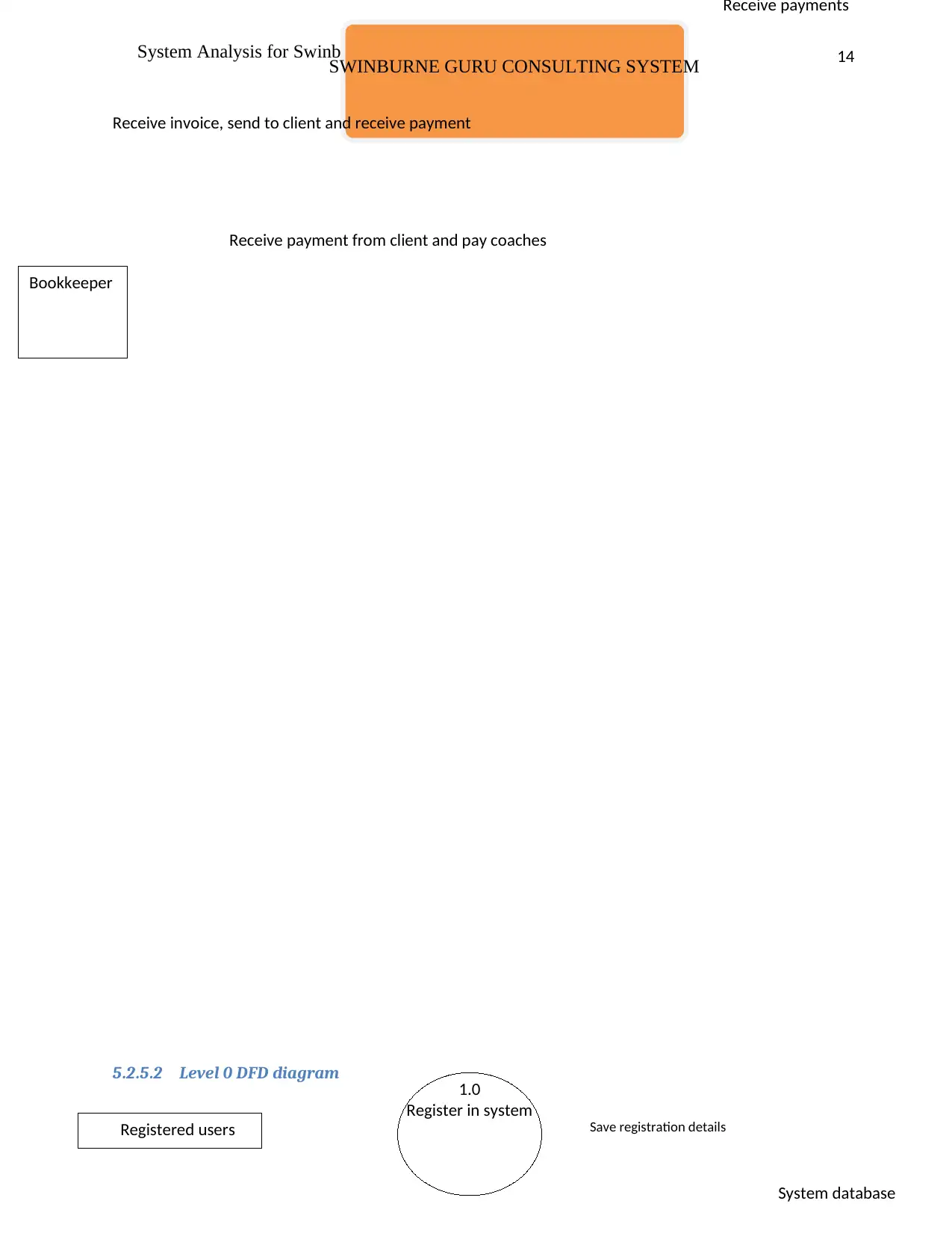
14System Analysis for Swinburne Guru Consulting
Bookkeeper
SWINBURNE GURU CONSULTING SYSTEM
Receive payments
Receive invoice, send to client and receive payment
Receive payment from client and pay coaches
1.0
Register in system
System database
Save registration detailsRegistered users
5.2.5.2 Level 0 DFD diagram
Bookkeeper
SWINBURNE GURU CONSULTING SYSTEM
Receive payments
Receive invoice, send to client and receive payment
Receive payment from client and pay coaches
1.0
Register in system
System database
Save registration detailsRegistered users
5.2.5.2 Level 0 DFD diagram

15System Analysis for Swinburne Guru Consulting
2.0
Logged in system
5.0
Make payments
3.0
Chose a course
4.0
Receive invoice
Client Book keeper
Store course details
Receives the invoices from coach
Make the payments to coachSend payment to book keeper
Get the invoice amount
Do confirmation
Login the system
Enter registration details Logged in users
Selected courses
Received payments
Received invoices
1.1
Login system
System database
Retrieve logins
MAKE PAYMENTS Logged in users
5.2.5.3 Level 1 DFD diagram
2.0
Logged in system
5.0
Make payments
3.0
Chose a course
4.0
Receive invoice
Client Book keeper
Store course details
Receives the invoices from coach
Make the payments to coachSend payment to book keeper
Get the invoice amount
Do confirmation
Login the system
Enter registration details Logged in users
Selected courses
Received payments
Received invoices
1.1
Login system
System database
Retrieve logins
MAKE PAYMENTS Logged in users
5.2.5.3 Level 1 DFD diagram
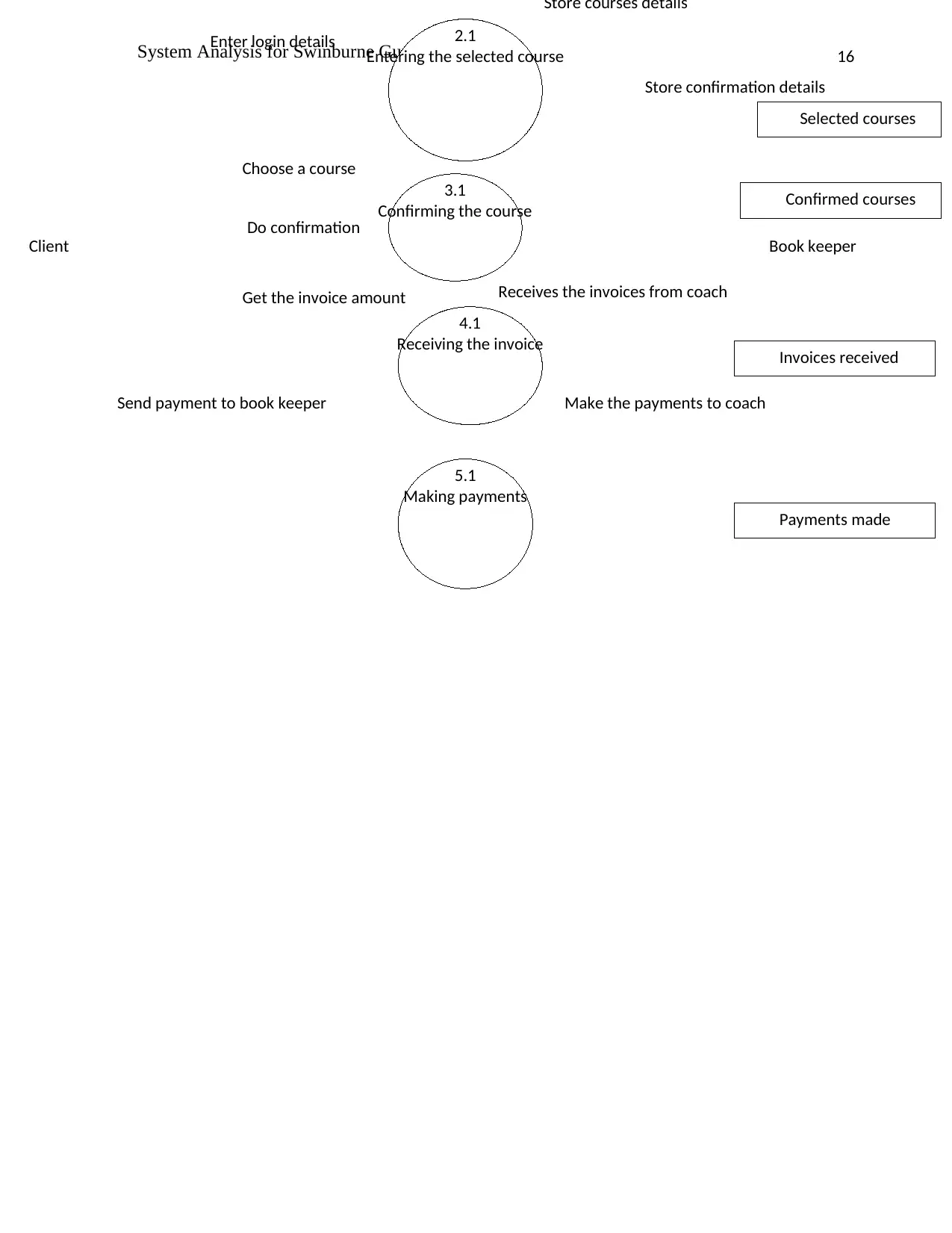
16System Analysis for Swinburne Guru Consulting
2.1
Entering the selected course
5.1
Making payments
3.1
Confirming the course
4.1
Receiving the invoice
Client Book keeper
Store courses details
Store confirmation details
Receives the invoices from coach
Make the payments to coachSend payment to book keeper
Get the invoice amount
Do confirmation
Choose a course
Enter login details
Selected courses
Confirmed courses
Invoices received
Payments made
2.1
Entering the selected course
5.1
Making payments
3.1
Confirming the course
4.1
Receiving the invoice
Client Book keeper
Store courses details
Store confirmation details
Receives the invoices from coach
Make the payments to coachSend payment to book keeper
Get the invoice amount
Do confirmation
Choose a course
Enter login details
Selected courses
Confirmed courses
Invoices received
Payments made
Secure Best Marks with AI Grader
Need help grading? Try our AI Grader for instant feedback on your assignments.

17System Analysis for Swinburne Guru Consulting
6 REFERENCES
Stephen,H.(2013) Management Information Systems with student CD and MISource.3rd edn.
New York:McGraw-Hill.
Paige,B.(2014) Business Driven Information Systems with MISource 2007 and Student CD.1st
edn New York: McGraw-Hill.
Specialist,I.(2018) CISSP Certified Information Systems Security Professional Study Guide
2018. 1st edn.New York:Independently published
Michael,J.(2017) Human Resource Information Systems: Basics, Applications, and Future
Directions. 5th edn.New York :SAGE Publications, Inc.
Dick,B.(2018) IT Project Management Essentials: Information Systems Project Methodology
Kindle Edition. 1st edn.New York:Amazon Digital Services LLC.
Tycho,p.(2014) Personal Finance Simplified: The Step-By-Step Guide for Smart Money
Management Paperback. 2nd edn.New York:Tycho Press.
6 REFERENCES
Stephen,H.(2013) Management Information Systems with student CD and MISource.3rd edn.
New York:McGraw-Hill.
Paige,B.(2014) Business Driven Information Systems with MISource 2007 and Student CD.1st
edn New York: McGraw-Hill.
Specialist,I.(2018) CISSP Certified Information Systems Security Professional Study Guide
2018. 1st edn.New York:Independently published
Michael,J.(2017) Human Resource Information Systems: Basics, Applications, and Future
Directions. 5th edn.New York :SAGE Publications, Inc.
Dick,B.(2018) IT Project Management Essentials: Information Systems Project Methodology
Kindle Edition. 1st edn.New York:Amazon Digital Services LLC.
Tycho,p.(2014) Personal Finance Simplified: The Step-By-Step Guide for Smart Money
Management Paperback. 2nd edn.New York:Tycho Press.
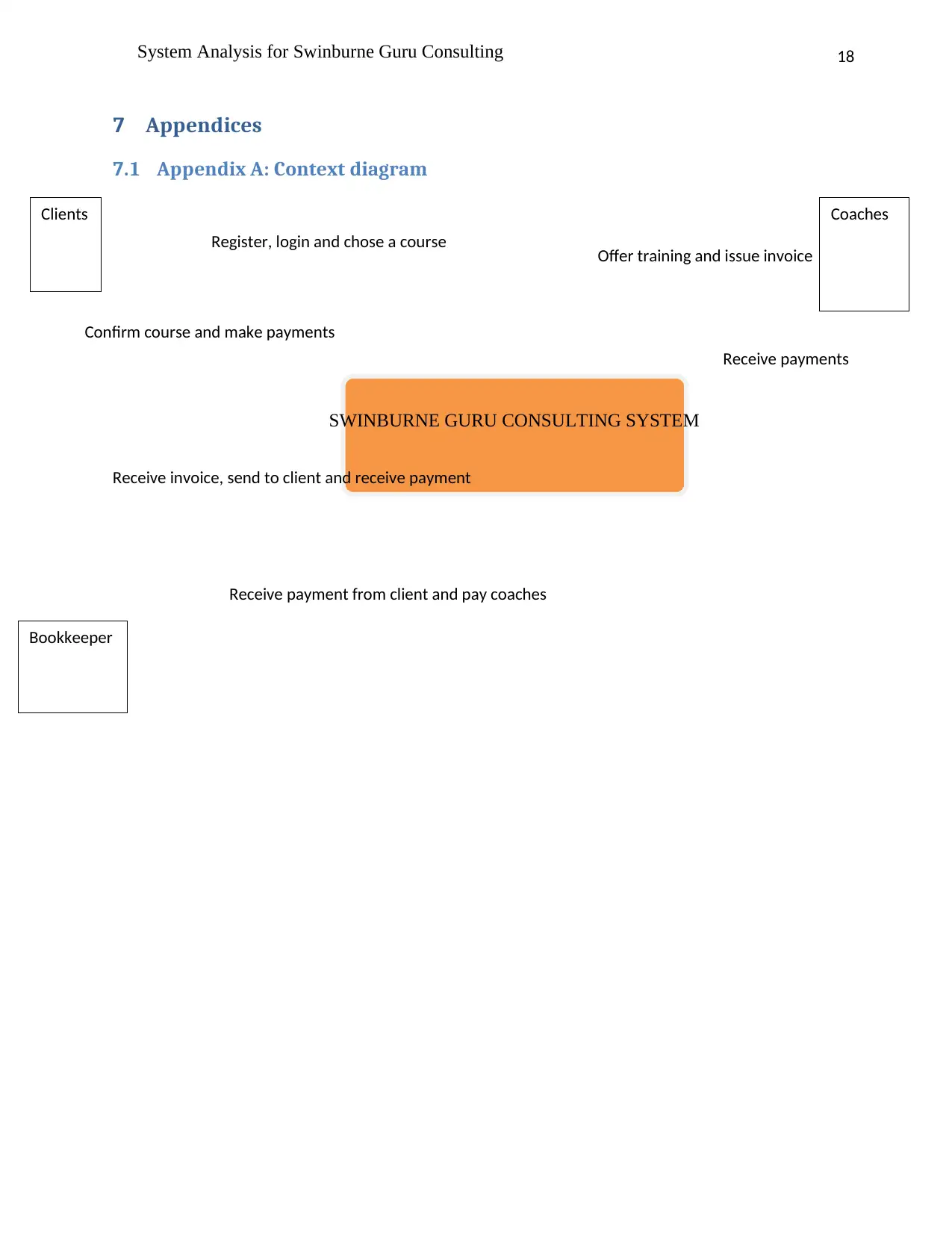
18System Analysis for Swinburne Guru Consulting
Bookkeeper
Clients Coaches
SWINBURNE GURU CONSULTING SYSTEM
Register, login and chose a course
Confirm course and make payments
Offer training and issue invoice
Receive payments
Receive invoice, send to client and receive payment
Receive payment from client and pay coaches
7 Appendices
7.1 Appendix A: Context diagram
Bookkeeper
Clients Coaches
SWINBURNE GURU CONSULTING SYSTEM
Register, login and chose a course
Confirm course and make payments
Offer training and issue invoice
Receive payments
Receive invoice, send to client and receive payment
Receive payment from client and pay coaches
7 Appendices
7.1 Appendix A: Context diagram
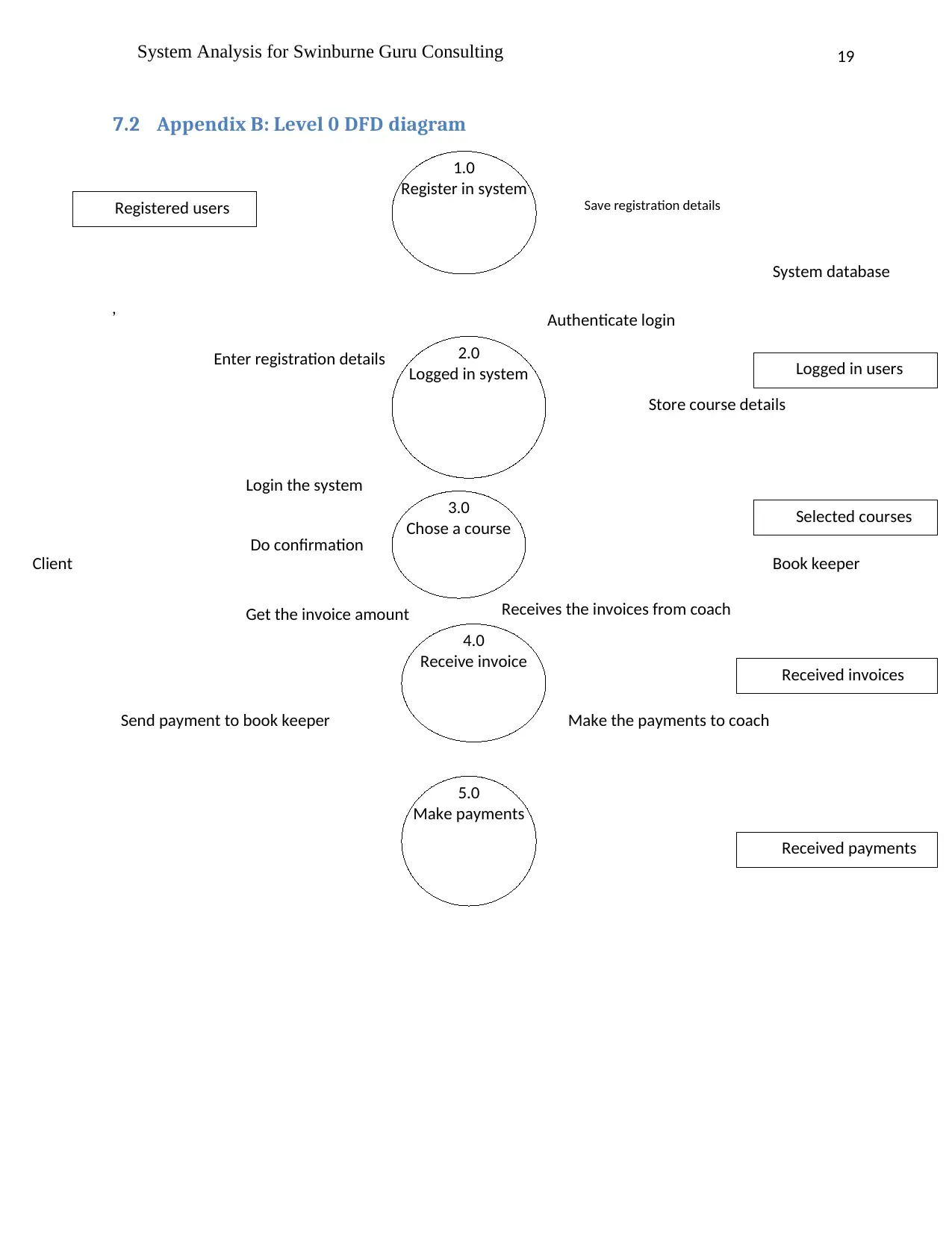
19System Analysis for Swinburne Guru Consulting
1.0
Register in system
2.0
Logged in system
5.0
Make payments
3.0
Chose a course
4.0
Receive invoice
System database
Client Book keeper
Save registration details
Authenticate login
Store course details
Receives the invoices from coach
Make the payments to coachSend payment to book keeper
Get the invoice amount
Do confirmation
Login the system
Enter registration details
Registered users
Logged in users
Selected courses
Received payments
Received invoices
7.2 Appendix B: Level 0 DFD diagram
,
1.0
Register in system
2.0
Logged in system
5.0
Make payments
3.0
Chose a course
4.0
Receive invoice
System database
Client Book keeper
Save registration details
Authenticate login
Store course details
Receives the invoices from coach
Make the payments to coachSend payment to book keeper
Get the invoice amount
Do confirmation
Login the system
Enter registration details
Registered users
Logged in users
Selected courses
Received payments
Received invoices
7.2 Appendix B: Level 0 DFD diagram
,
Paraphrase This Document
Need a fresh take? Get an instant paraphrase of this document with our AI Paraphraser
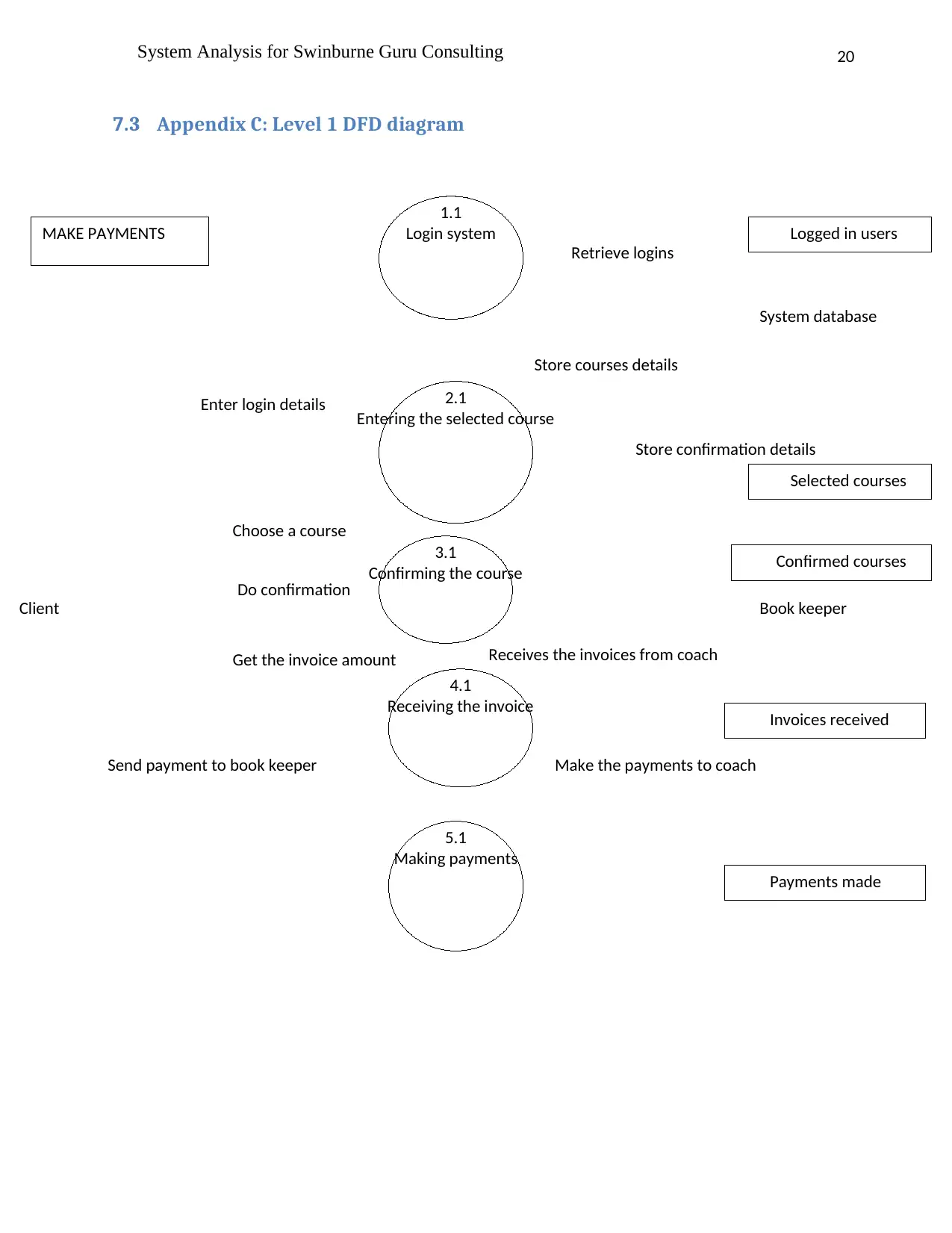
20System Analysis for Swinburne Guru Consulting
1.1
Login system
2.1
Entering the selected course
5.1
Making payments
3.1
Confirming the course
4.1
Receiving the invoice
System database
Client Book keeper
Retrieve logins
Store courses details
Store confirmation details
Receives the invoices from coach
Make the payments to coachSend payment to book keeper
Get the invoice amount
Do confirmation
Choose a course
Enter login details
MAKE PAYMENTS Logged in users
Selected courses
Confirmed courses
Invoices received
Payments made
7.3 Appendix C: Level 1 DFD diagram
1.1
Login system
2.1
Entering the selected course
5.1
Making payments
3.1
Confirming the course
4.1
Receiving the invoice
System database
Client Book keeper
Retrieve logins
Store courses details
Store confirmation details
Receives the invoices from coach
Make the payments to coachSend payment to book keeper
Get the invoice amount
Do confirmation
Choose a course
Enter login details
MAKE PAYMENTS Logged in users
Selected courses
Confirmed courses
Invoices received
Payments made
7.3 Appendix C: Level 1 DFD diagram
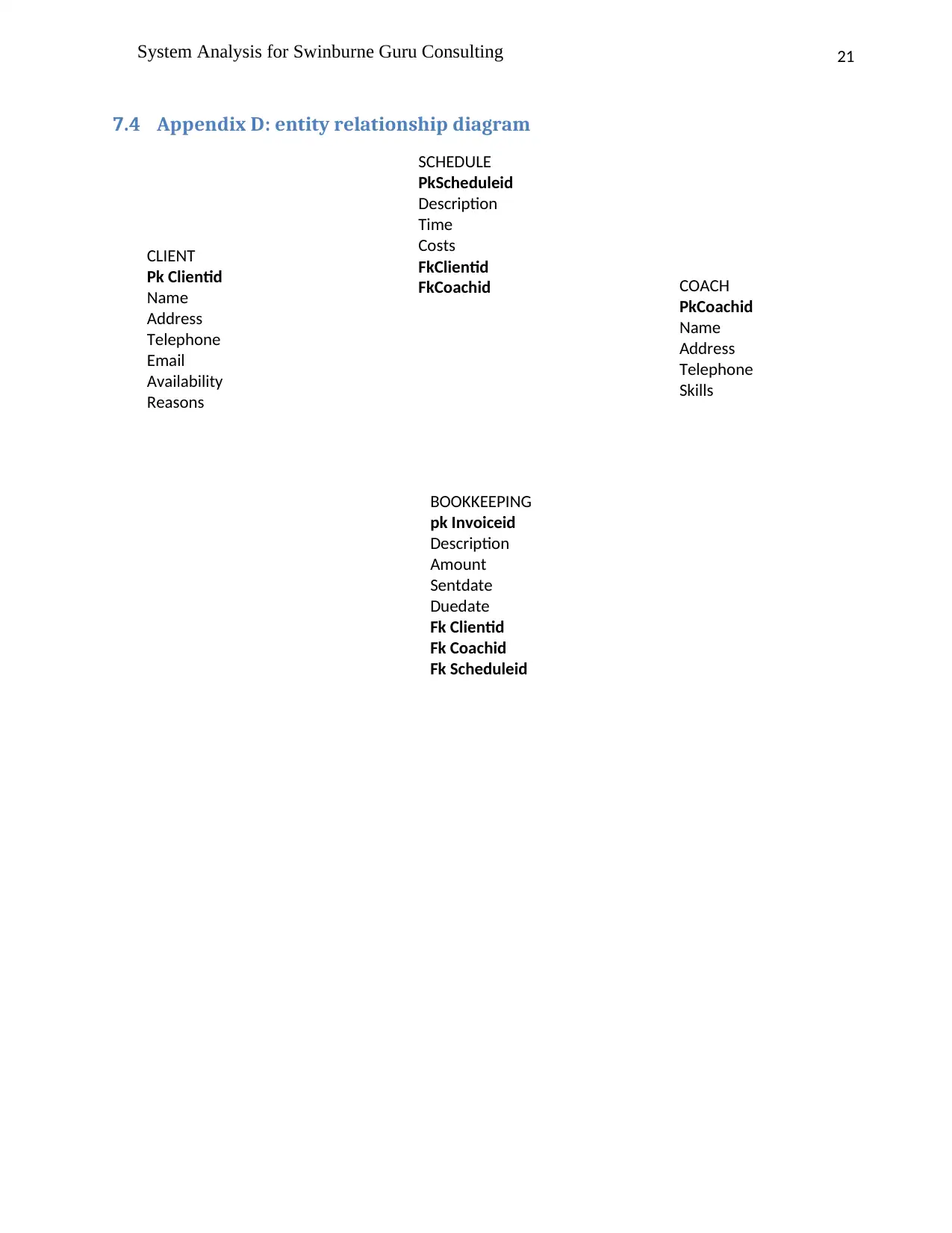
21System Analysis for Swinburne Guru Consulting
CLIENT
Pk Clientid
Name
Address
Telephone
Email
Availability
Reasons
COACH
PkCoachid
Name
Address
Telephone
Skills
SCHEDULE
PkScheduleid
Description
Time
Costs
FkClientid
FkCoachid
BOOKKEEPING
pk Invoiceid
Description
Amount
Sentdate
Duedate
Fk Clientid
Fk Coachid
Fk Scheduleid
7.4 Appendix D: entity relationship diagram
CLIENT
Pk Clientid
Name
Address
Telephone
Availability
Reasons
COACH
PkCoachid
Name
Address
Telephone
Skills
SCHEDULE
PkScheduleid
Description
Time
Costs
FkClientid
FkCoachid
BOOKKEEPING
pk Invoiceid
Description
Amount
Sentdate
Duedate
Fk Clientid
Fk Coachid
Fk Scheduleid
7.4 Appendix D: entity relationship diagram
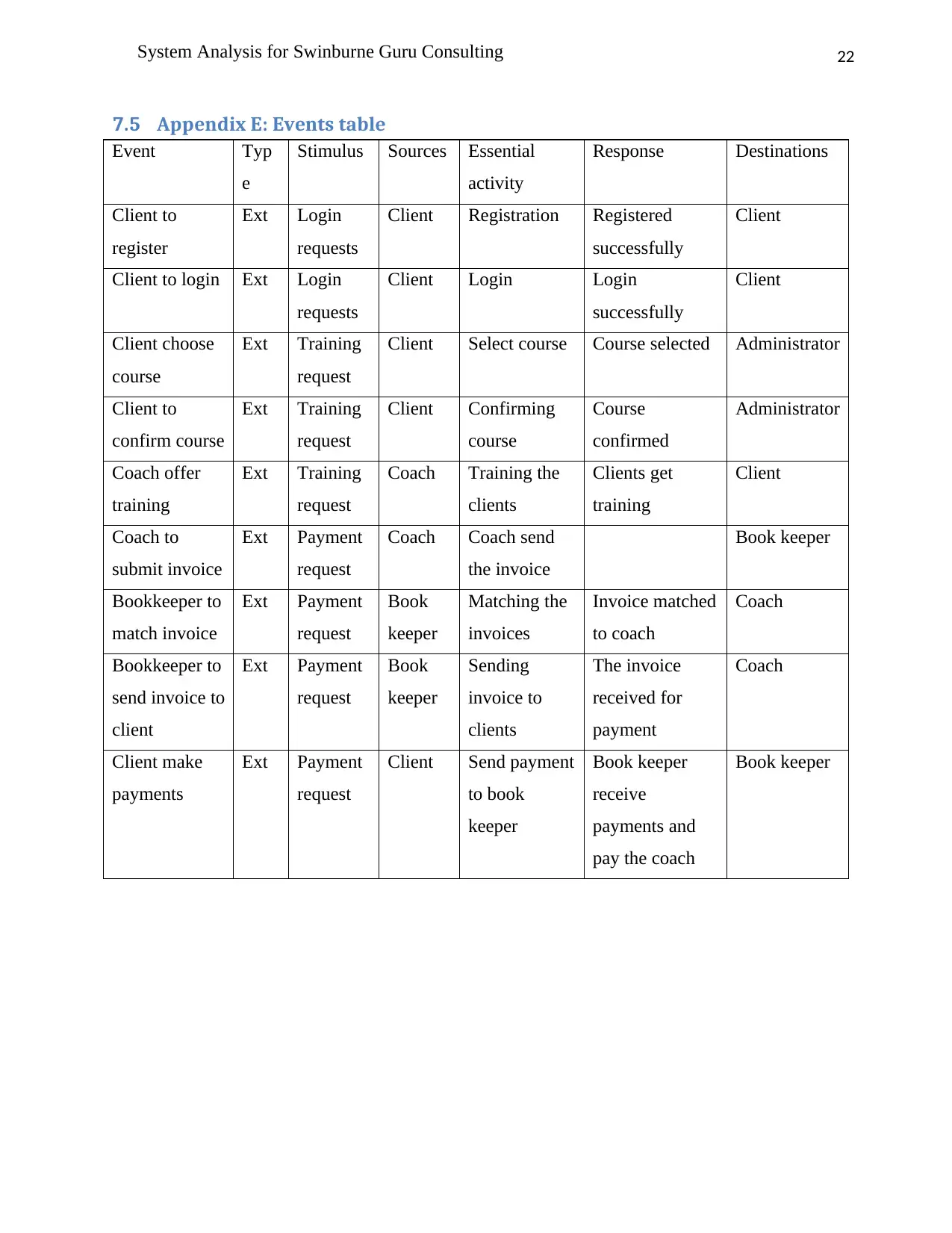
22System Analysis for Swinburne Guru Consulting
7.5 Appendix E: Events table
Event Typ
e
Stimulus Sources Essential
activity
Response Destinations
Client to
register
Ext Login
requests
Client Registration Registered
successfully
Client
Client to login Ext Login
requests
Client Login Login
successfully
Client
Client choose
course
Ext Training
request
Client Select course Course selected Administrator
Client to
confirm course
Ext Training
request
Client Confirming
course
Course
confirmed
Administrator
Coach offer
training
Ext Training
request
Coach Training the
clients
Clients get
training
Client
Coach to
submit invoice
Ext Payment
request
Coach Coach send
the invoice
Book keeper
Bookkeeper to
match invoice
Ext Payment
request
Book
keeper
Matching the
invoices
Invoice matched
to coach
Coach
Bookkeeper to
send invoice to
client
Ext Payment
request
Book
keeper
Sending
invoice to
clients
The invoice
received for
payment
Coach
Client make
payments
Ext Payment
request
Client Send payment
to book
keeper
Book keeper
receive
payments and
pay the coach
Book keeper
7.5 Appendix E: Events table
Event Typ
e
Stimulus Sources Essential
activity
Response Destinations
Client to
register
Ext Login
requests
Client Registration Registered
successfully
Client
Client to login Ext Login
requests
Client Login Login
successfully
Client
Client choose
course
Ext Training
request
Client Select course Course selected Administrator
Client to
confirm course
Ext Training
request
Client Confirming
course
Course
confirmed
Administrator
Coach offer
training
Ext Training
request
Coach Training the
clients
Clients get
training
Client
Coach to
submit invoice
Ext Payment
request
Coach Coach send
the invoice
Book keeper
Bookkeeper to
match invoice
Ext Payment
request
Book
keeper
Matching the
invoices
Invoice matched
to coach
Coach
Bookkeeper to
send invoice to
client
Ext Payment
request
Book
keeper
Sending
invoice to
clients
The invoice
received for
payment
Coach
Client make
payments
Ext Payment
request
Client Send payment
to book
keeper
Book keeper
receive
payments and
pay the coach
Book keeper
Secure Best Marks with AI Grader
Need help grading? Try our AI Grader for instant feedback on your assignments.
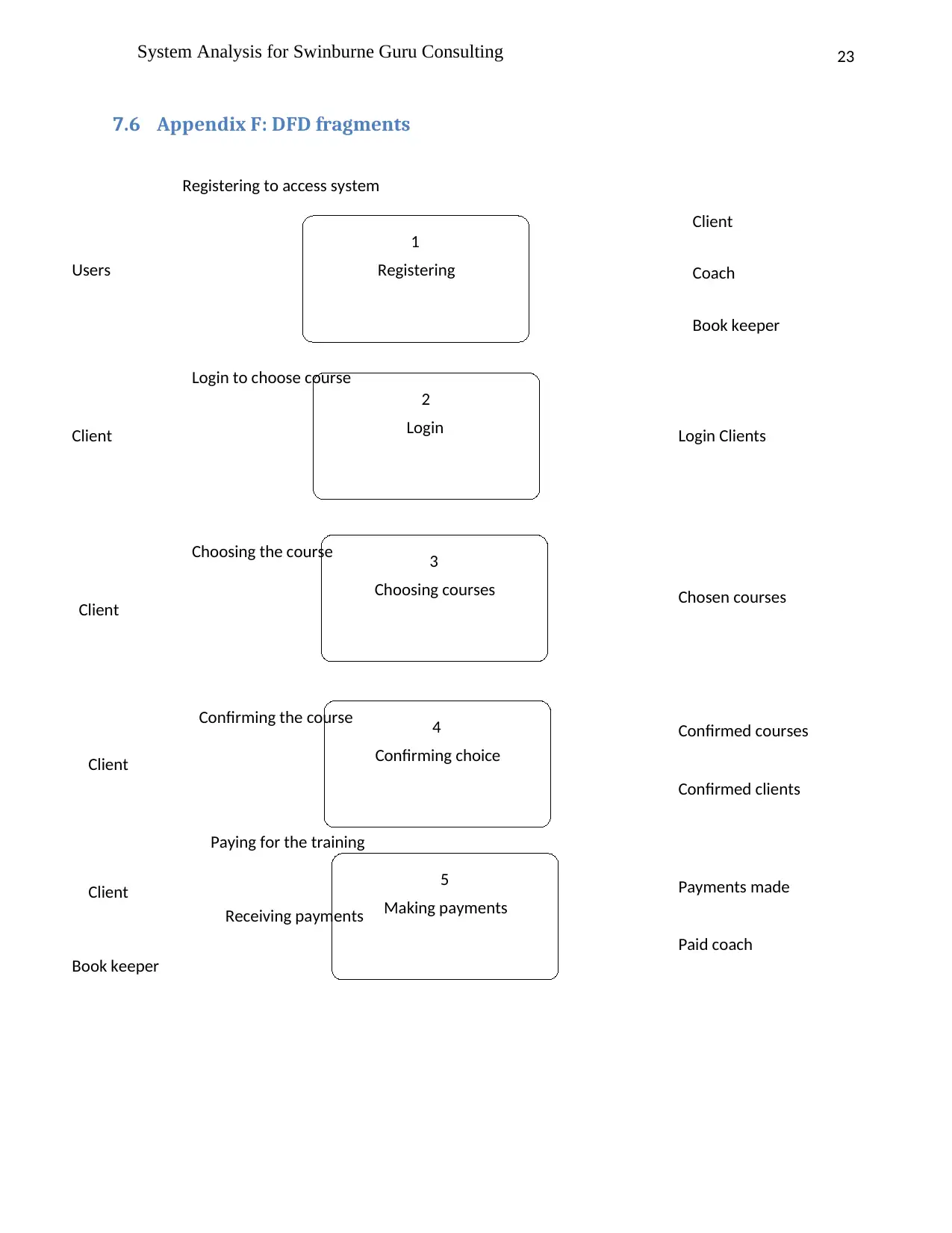
23System Analysis for Swinburne Guru Consulting
1
RegisteringUsers
Registering to access system
Client
Coach
Book keeper
2
LoginClient
Login to choose course
Login Clients
3
Choosing courses
Client
Choosing the course
Chosen courses
5
Making payments
Client
Book keeper
Paying for the training
Receiving payments
Payments made
Paid coach
4
Confirming choice
Client
Confirming the course Confirmed courses
Confirmed clients
7.6 Appendix F: DFD fragments
1
RegisteringUsers
Registering to access system
Client
Coach
Book keeper
2
LoginClient
Login to choose course
Login Clients
3
Choosing courses
Client
Choosing the course
Chosen courses
5
Making payments
Client
Book keeper
Paying for the training
Receiving payments
Payments made
Paid coach
4
Confirming choice
Client
Confirming the course Confirmed courses
Confirmed clients
7.6 Appendix F: DFD fragments
1 out of 23
Related Documents
Your All-in-One AI-Powered Toolkit for Academic Success.
+13062052269
info@desklib.com
Available 24*7 on WhatsApp / Email
![[object Object]](/_next/static/media/star-bottom.7253800d.svg)
Unlock your academic potential
© 2024 | Zucol Services PVT LTD | All rights reserved.





